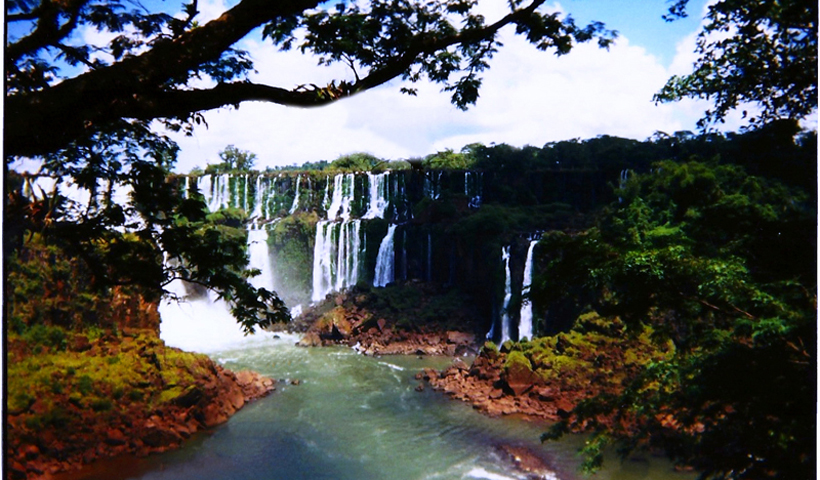A JOURNEY INTO THE DEVIL’S THROAT
Paula Ann Murphy
OUR SHIP ARRIVED EARLY as the fog rose in Paranagua, Brazil. After hiking in the mist, we rode to the Curituba airport and boarded a chartered aircraft destined for Iguassu Falls. The falls are on the Parana, a river that separates Brazil from Argentina in a sub-tropical jungle. There are monstrous pine trees, white sands twisting through thick vegetation, with several miles of rushing water out of the bowels of Brazil plunging 240 feet deep, ending at the Devil’s Throat (La Garganta Del Diablo). I remember looking down into the Devil’s Throat and feeling mystified — the water roaring like a white tornado nearly the size of Texas.
Our guide, mixing Portuguese with English, instructs my husband, Dan, and me on our journey into this jungle. The leaves are larger than your hand, with vines strung like spaghetti from the sky. I take note of a snake warning sign. Bugs the size of small bats whisk our faces. After we clear tree limbs hiding the eye of a white sandy knob about a mile from the Devil’s Throat, we board a motorized raft. Another snake sign is glaring at me from shore. The air smells thick at 110 degrees. Fear and heat dance upon our flesh. Dan tells me my cheeks are turnips. I am purple and exhausted, but excited to continue.
As we float up the river along 50-foot walls, the rocks chant to me. Water mists my face. Minerals luxuriously seep from the cliffs, like a European spa treatment. As the pace of the motor picks up, we come closer to the Devil’s Throat, the tallest of Iguassu’s 275 falls. Damn that foreign guide — without warning, he sprints us into tall white water, gunning the small craft under the falls. I can’t see anything, but I can feel the fierce heat from the Devil’s Throat.
I can barely contain my body inside the raft; holding on tight I can feel the rope burns on my hands. Then I hear, “Are you scared?” I reply in a sweet voice, “Of course not, honey.” My mind ignores painful blisters forming on my hands, as I think about snake signs again.
There is a firm, fast thumping within my chest. The dark cave and a feeling of immortality both claim me. With the same vigorous energy, we exit the falls the way we came in — only now it seems peaceful. On our return to the white sandy knob I take in every detail. Nature has polished the cliffs smooth. Glaring sun rays peek between rocks. Then I step onto soft white sand as water droplets form crystal beads at my feet.
We are told to climb the mountain on the left, and follow the path. A one-hour journey is ahead. I am fatigued. Dan looks toward the climb and comments, “Apparently, there are no lawyers in Brazil!”
There are a few crumbling ancient stairs. The polished rock is slippery. We are shaking and heavy from our wet clothing. The 40-foot drop is in the back of my mind every moment of the climb. Until I see another snake sign. Eventually we rest for a time and take in the Iguassu view at the top. I think in our moments of silence we both thanked the Brazilian gods — not only for the view, but to be on flat land.
On the hike back, I continually thought about those damn snake signs; 21 of them along the path, no words, just primitive black and white drawings with exclamation marks in red. The snakes are called “perigoso.” They come up out of nowhere in this crazy country. It seems like a long desert bending around the Devil’s Throat with a jungle intertwined to hide the miles and miles of snakes.
In the early part of the hike, I had done something very stupid. I had desperately wanted a picture of a banana tree heavy with its fruit. Handfuls of lime-colored bananas drape from huge wavy leaves growing out of thick trunks. So I waited until no one was looking, ran into the brush, took a photo of a lonely banana tree, and rejoined the group on the trail without my absence noticed.
But at dinner my stupidity confronted me — I could have been bitten, left paralyzed, or found lifeless on the ground. So I gave thanks again to the Brazilian gods; my venturesome spirits jostle me and can get me into trouble. But since that day, I look at everything and see something else, something more. Our paved American roads and big framed houses seem cold now. To survive the Iguassu makes the big things here seem small, and less than significant. As for the snakes — they haunt me still.
Paula Ann Murphy is a highly regarded graphic designer, who has done web, print-promotion, branding and corporate identity, along with award winning art and design for companies across the country, and around the world. Rumor has it that she had something to do with the design of the Roel Resources website. You can contact Paula at paulam@branditarians.com


